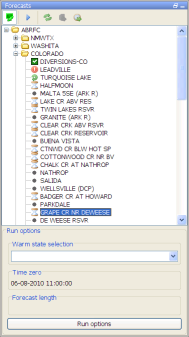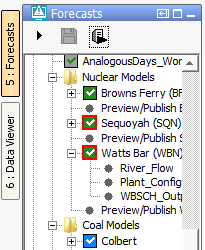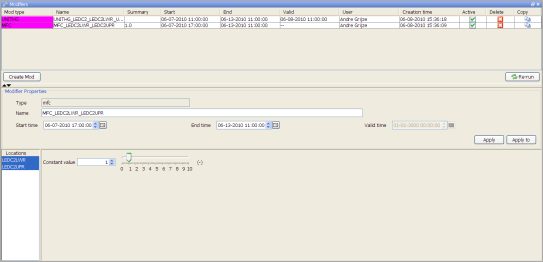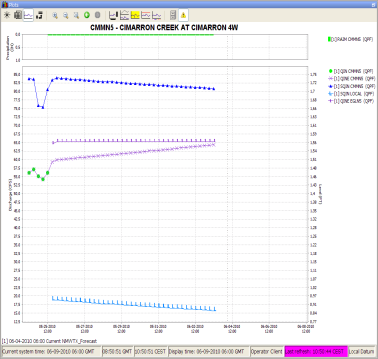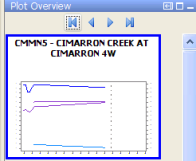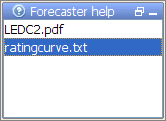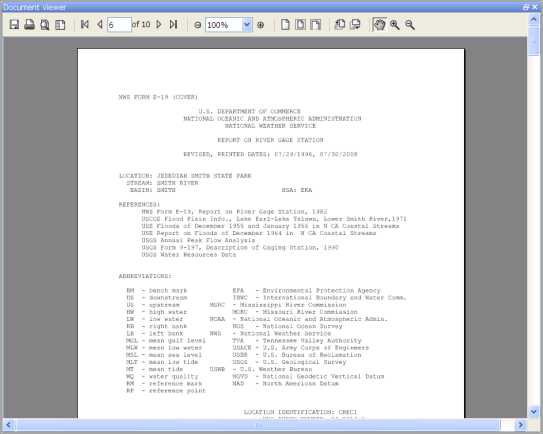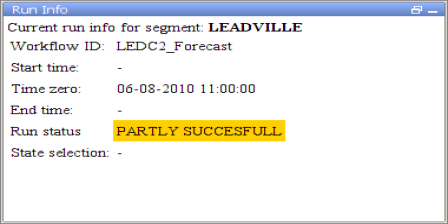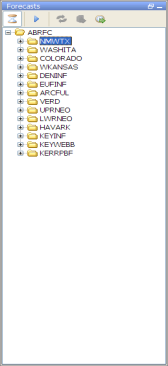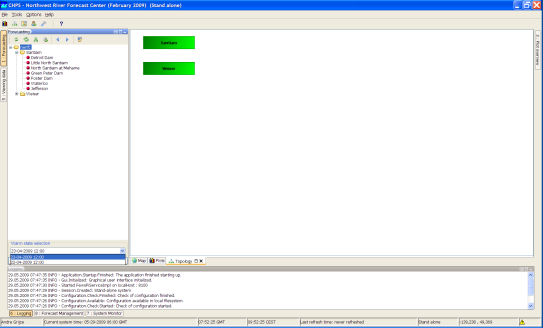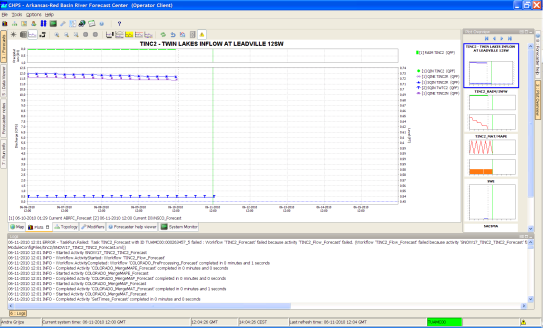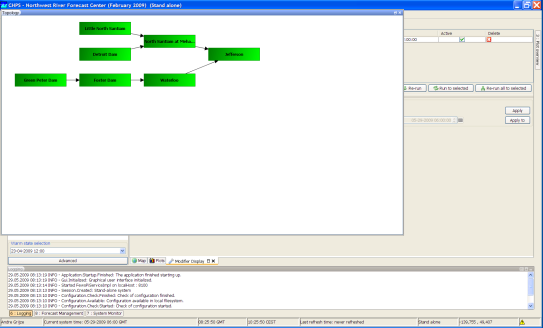iWhat is the IFD?
The IFD is short for Interactive Forecast Displays.
The IFD is a set of displays which enable the forecaster to create a forecast manually in comparison to a batch run which creates a forecast in a background process triggered either by a schedule or manually.
When a forecaster creates a forecast in the IFD, the forecast created in the background process is usually used as the starting point for the forecaster.
The forecaster validates the results from the server run and adjusts the forecast by using modifiers where needed.
When the forecaster is satisfied with the adjusted forecast the forecast is finalized and published to other forecasters.
Usually when creating a forecast by using the IFD, FEWS runs in a mode where all the windows are dockable.
This is an important aspect of the IFD because this feature enables the forecaster to keep an overview of the system.
Contents
Which displays are used in the IFD?
The IFD consists of several panels.
Each of these panels has a specific role in the process of creating a forecast with the IFD.
In this chapter the functionality of each panel in the IFD will be explained.
In the next chapter will be explained with a use case how a forecast can be created with the
IFD by using the combined functionality of the separate panels.
Forecast panel
The forecast panel plays a central role in creating a forecast in the IFD.
The forecast panel shows a tree with all the forecast points for a region and the grouping of these forecast points.
Each node in the tree can be linked to a workflow. For example node EAGLE NEST DAM has its own workflow.
Each node also shows the current status of the last run of the workflow to which the node refers.
Workflows of parent nodes are always run on the server. By default leaf nodes are locally run, however it is also possible that these workflows are run on the server.
This can be done by setting the optional tag localRun to false for a node.
The leaf nodes are indicated by the small black balls in the display, parent nodes (node containing other parent nodes or leafs) are indicated as a folder in the forecast display.
When a leaf node is selected the ifd will automaticly run the workflow of that node.
This behaviour can however be disabled in the configuration by setting the enableAutoRun-tag to false in the topolog.xml.
If the node shows a green checkbox (as is seen in the image above at the node DIVERSIONS-CO) item it means that the workflow has run successfully.
A red exclamation (as is seen in the image above at the LEADVILLE node) mark indicates that the workflow is failed.
A yellow ball indicates that the workflow was successful in a prior run, but the results have since been invalidated by some upstream change.
For example, when the forecaster has created a modifier but did not rerun the workflow yet.
Or when an upstream node was run later than one off its downstream nodes then the results of the downstream nodes are set to invalid.
When a folder is shown for a parent node (as is seen for the COLORADO node in the image below) or a black ball for a leaf node (as is seen in the MALTA 5SE node) then the workflow has not run yet for the current time zero.
A green arrow (as is seen in the node TURQUOISE LAKE) indicates that the workflow is currently running (locally or at server).
An hour glass (see node HALFMOON above) indicates the workflow is scheduled to run.
As part of 2014.02, the color of the forecast icons has changed (see figure below).
We still have the green and blue boxes with the white check marks. They represent a server (green) or local (blue) run, with the same T0 and state settings as shown in the IFD.
Prior to 2014.02 you would not see an icon at all if the T0 in the IFD was different than the T0 of the approved run in the database, or if the state settings in the IFD were different than the state settings of the approved run in the database. For releases starting with 2014.02, you will see multiple icons for the various situation:
A grey box with either a green or blue check mark. A grey box means the T0 of the approved run in the database is different than the one in the IFD. The check mark indicates whether the approved run is a local or a server run.
A yellow box with either a green or blue check mark. A yellow box means the state settings of the approved run in the database are different than the settings in the IFD. For example you might have a different warm state, warm state search interval, or forecast length. The check mark indicates whether the approved run is a local or a server run."
As of 2016.01, The IFD status icon can be surrounded by a red outline. See figure below. This red outline surrounding the IFD status icon indicates that the workflow task completed but not all of the data has been synchronised back to the operator client. This red outline feature is disabled for DDA clients as it pertains only to synchronisation in LDS clients.
Go to next segmentAdjust T0
Run on ServerForecast/View-button
Re-Run button
At the top of the forecast panel several buttons are shown.
The first button is a Forecast/View toggle button (Put image of the button here) which can be used to switch from View mode to Forecast mode.
In the Forecast mode the forecaster can create modifiers and when a leaf node is selected the workflow is run automatically . In View mode the forecaster can view the results of other forecasts.
However, it is not allowed to create modifiers and workflows will not be run automatically when a node is selected. A workflow can be forced to run by pressing the Re-Run button.
The second button is the Go to Next Segment-button (image of button here). By pressing this button automatically the next leaf-node in the forecast panel will be selected.
The third button is the Re-Run-button (need button image). This button is only enabled when a node is selected which has a workflow which runs locally.
The fourth button is the 'Run on Server'-button (need button image here). This button is only enabled when a node is selected with a workflow which should run on the server.
The last button is the Adjust T0 (need image of button) button which allows the forecaster to adjust the current system time to the nearest cardinal time step prior to the current time.
At the bottom of the forecast panel there is a Run options section. In this section the forecaster can set the properties of the run. The warm state can be selected and the current Time zero is also displayed. More advanced options are available with the button Run options.
Modifiers panel
The modifiers panel is an important display in the IFD.
It shows the modifiers which are created for a certain node. Modifiers can be created, modified or deleted in this panel.
The upper part of the display gives an overview of the modifiers created for the currently selected node in the forecaster panel.
It lists the Start Date, the End Date, the Valid Date and the Creation time of the mod.
It also allows the user to make mods active and inactive with the checkbox in the column Active.
A mod can be deleted by pressing the red cross icon and a copy can be made pressing the copy-icon.
With the create mod-button the forecaster can create new modifiers. When the button is pressed a dropdown-list with the available modifier types for the currently selected node is shown.
The modifiers which are shown are depended on the models, transformations and module parameterfiles available in the workflow of the selected node and the plots which are associated with the node.
In the modifierTypes.xml is defined which modifiers are available for the forecaster. The combination of the configuration of the modifierTypes.xml and the workflow and the time series in the plots
When a modifier type is selected, the details of the new modifier is shown is in the lower part of the display. In some cases it is also necessary to specify to which models the modifier should be applied.
For example when the forecaster selects the modifier type MFC and there are two SNOW17-models available in the segment, the forecaster should also specify to which models the modifier should be applied.
When the modifier can be applied to more than one model in a basin a 'location'-panel shows up at the left part of the details display. In this panel the forecaster can select to which locations the modifier should be applied.
The Re-run button runs the workflow from the selected node and the workflows from the upstream nodes.
The lower part of the display shows the details of the selected modifier or when the forecaster is creating a new modifier the details of the new modifier.
Topology panel
The topology panel shows the topology of the selected node. When a leaf node is selected the topology of the parent node is shown. When a parent node is selected the topology of its children is shown.
The colors of the boxes in the topology change when a threshold is passed. The color of the box and the thresholds which are monitored can be configured.
Plot
The plot display is used to show scalar time series. Each node has its own set of predefined displays configured. When a node is selected the plots display automatically updates the plots which are already displayed to show data for the new node. The first plot configured for the selected node is automatically shown in this display.
When the IFD is started, there is always at least one plot display available. This plot is called the primary plot display. The primary plot doesn't have lock icon at the left of the toolbar. When a new plot display is started this plot will have a lock icon at the left on the toolbar. When a new plot displayed is started, by default the plot will be locked.
When a plot is locked, the display is locked to that set of time series. When the forecaster moves from basin to basin, the plot will continue to display the original timeseries. The plot is not updated. However, as new data is brought in, the plot is updated with new data.
When the toggle-button is switched off (icon changes to unlock) the plot window is updated automatically when a new node is selected.
Plot overview
The plot overview is a panel which shows a thumbnail of each plot which is configured for the selected node. This panel gives an overview of the selected node. This overview is enabled by configuring the following task in the explorer tasks; nl.wldelft.fews.gui.plugin.displaythumbnails.ShortcutsThumbnailsDialog
When a plot is selected the primary plot is automatically updated, also other plots display which are not locked (see previous chapter) are updated. Primary plot is defined by including the following task in the explorer tasks: nl.wldelft.fews.gui.plugin.timeseries.PlotsTimeSeriesDialog. Is such task is not defined the Plot Overview works only if a time series dialog window is open.
At the top of the panel there are four buttons. The first button selects the first plot, the second button selects the previous plot, the third button selects the next plot and the last button selects the last plot.
Forecaster help
The forecaster help panel shows user provided documentation which is available for a node.
Currently the following formats are supported: textfiles, images and pdf-files.
Users can place documents in a directory within predefined directories.
These directories can be configured in the topology.xml configuration file by adding a forecasterHelperDirectories element that contains a directory element for all directories.
For instance:
<forecasterHelperDirectories> <directory>d:\Data\ForecasterHelperData\</directory> <directory>d:\Data\FHD3\</directory> </forecasterHelperDirectories>
If this is not present in the topology.xml the directory in the global.properties defined by the INFORMATION_PANEL_FOLDER property will be used.
Within these directories each node has its own directory. The directory should have the same name as the node id.
Within that directory the documentation for that node can be placed.
If you make use sub-folders, make sure to also include the main folder as a directory when you list the <forecasterHelperDirectories>. Documents in the folder configured as <allNodesDirectory> will be visible at all nodes.
<forecasterHelperDirectories> <directory>$DOCUMENTS_ROOT_FOLDER$</directory> <directory>$DOCUMENTS_ROOT_FOLDER$/subfolder_1/</directory> <directory>$DOCUMENTS_ROOT_FOLDER$/subfolder_2</directory> <allNodesDirectory>$DOCUMENTS_ALWAYSVISIBLE_FOLDER$</allNodesDirectory>--> </forecasterHelperDirectories>
Below an example of the tool window forecaster help. In this example the forecaster has two documents available for information.
If multiple directories are configured this window will show all available files for the node from the different predefined directories together.
When one of the files is selected in this panel the content of the selected file is shown in the document viewer.
The document viewer is a dockable window in the centre of FEWS.
When a text file is selected it can also be edited. To facilitate this an edit and save button are displayed above the document when selecting a text file.
The content of the forecast help dialog is depended of which node is selected in the forecaster panel.
When a new node is selected the content of the forecaster help dialog is automatically updated.
To add the Forecaster help panel and document viewer to the Delft-FEWS explorer, please add the following tasks to Explorer.xml:
<explorerTask name="Forecaster help"> <taskClass>nl.wldelft.fews.gui.plugin.information.ForecasterAidSelectionPanel</taskClass> </explorerTask> <explorerTask name="Documents viewer"> <taskClass>nl.wldelft.fews.gui.plugin.information.ForecasterAidDocumentPanel</taskClass> </explorerTask>
Run info
The run info panel shows detail information of the latest run of the workflow of the selected node.
If the workflow of the node has not run yet for the current T0 then the panel will show that there is no current run info available
When the workflow has run. The status can either be succesfull, failed or partly successful.
Only when the workflow was succesfull than the icon of that node will be set to green. The run status will be shown green in the run info box.
When the run is partly successful the icon of that node will be set to the red exclamation mark, the run status box in the run info panel will be set to yellow. When the run is failed the icon of the node will be set to the red exclamation mark, the run status box will be set to red.
Forecaster notes
The forecaster notes panel shows the notes other forecaster have created regarding their previous forecasts for the forecast point. Forecasters can also created their own note and publish them.
How to create a forecast with the IFD
Steps in creating a forecast
Below is a list of all possible steps in creating a forecast with the IFD. Please note that not all of the listed steps are obligated. For each step will be explained how this step can be carried out using the IFD in FEWS.
- Start FEWS
- Selecting the forecast panel
- Reviewing the topology
- Review the list of available state date/times
- Adjust state and/or forecast length
- Starting the forecast process and selecting the workflow for which the forecast should be made
- Reviewing workflow status
- Reviewing graphs (graph display listens to segment selection)
- Reviewing graphs (graph display is independed from segment selection)
- Continue with the forecast process downstream
- Ending the forecast process
Starting FEWS
After starting FEWS, the map-display will be displayed in the centre and the Forecast Panel-tab at the left will be selected.
This the default layout. The layout after starting FEWS is however configurable by creating and saving a custom layout by using the option in the File menu at the top left of the display.
First the IFD will try to synchronize the local datastore with the central database.
Until that process is finished it is not possible to create a forecast with the IFD.
To indicate that the IFD is doing its initial synchronization after startup the forecast-button shows a hour glass icon.
While the Operator Client if synchronizing, it is possible to view scalar and spatial data.
When the initial synchronization is finished. The following message is shown.
Selecting the forecast panel
The whole process of creating of forecast by using the IFD is managed by the forecast dialog, therefore the first step is selecting the Forecast tab at the left of the display. The Forecast tab will give an list, in computational order of the basins of the region.
Review the list of available state date/times
The forecast panel also shows at the bottom the currently selected (default) warm state. By clicking on the drop-down box all the available warm states are shown. If the forecaster needs to use a different warm state than the default, a new warm state date may be selected from drop down menu titled Warm State Selection. If the default warm state is not correct another warm state can be selected from the drop-down box.
Adjust state and/or forecast length
By pressing the Run Options button at the bottom of the forecast dialog the user will have access to alternative ways of selecting states. After pressing the advanced button a dialog will be shown in which the user can select the state, forecast length and a what-if scenario.
After selecting the OK-button the selected state or forecast length will be applied and used in the runs.
Starting the forecast process
To start the interactive forecast process, the user should select a leaf node. If the IFD is in forecast mode (which it is by default) the workflow of the selected node will also be automatically run. Models can be run by selecting a node, or pressing the rerun button.
In view mode the forecaster can view data but it is not possible to create a forecast.
Reviewing run status workflow
When a run is finished the segment-dialog will show the status of the run.
If a run is in progress a refresh-icon will be shown. A green box will indicate a successful run.
A red exclamation mark will indicate that run workflow has failed.
A yellow dot will indicate the workflow has run succesfully but that the results are invalid.
For example when an upstream segment has run later than the workflow for a downstream segment the results of the downstream segment workflow are invalid.
The icons displayed on the leaf node (for individual basins) indicate the status of local runs. If the icon is blank then the server run is the most recent run. Icons on the parent nodes indicate the status of server runs.
Review graphs (graph display listens to segment selection)
When a basin run has finished the results of the run should be reviewed. By selecting the plot overview at the right a list of thumbnails will be displayed. For each graph available for the current node a thumbnail will be shown. To display a graph, the forecaster selects a thumbnail and then this graph is displayed in the main plot window. The plot display will show the selected graph. Navigation between the graphs can be done by selecting a graph by clicking on a thumbnail with the mouse or by pressing alt+g (go to next graph) or by pressing shift+alt+g(go to previous graph). When the Thumbnail Panel is selected it is also possible to navigate by using the arrow keys up and down on that panel. When a new node is selected in the Forecast Tab the list of thumbnails is automatically updated to show the graphs available for the newly selected node.
The Plot Overview panel can be undocked. When the display is expanded the plots are automatically resized.
Creating a mod in the time series display
Mods can be created in the mods display or directly in the plot display. To modify a time series directly in a plot, a time series has to be selected. This can be done by selecting a time series in the legend of the plot. To indicate that a time series is selected the legend and the time series will be plotted bold.
Creating a mod in the mods display
The modifier display can be started by clicking on the wrench-icon at the toolbar or by using the shortcut ctrl+m. The modifier display will show all the mods which are applied in the currently selected segment. By clicking on the create mod-button a new mod can be created. After pressing the create mod-button a list of available mods will be shown. When the mod is created it can be applied by pressing the apply-button. With the run-buttons (rerun, rerun to selected and rerun all to selected) it is possible to rerun the workflows. Pressing the run-buttons will also automatically apply the mod.
Continue with the forecast process downstream
After reviewing the graphs and if needed applying mods the forecaster can proceed to the next segment. Going to the next segment can be done easily by pressing alt+s (go to next segment) or by pressing the next segment-button in the forecast panel or by selecting the next node. After selecting the segment the workflow will be run automatically and after finishing the run the status of the run will be shown by color of the dot of the segment.
Ending the forecast process
When the forecaster thinks that the current forecast is sufficient. The forecast can select the parent node of the leaf nodes and press the 'run on server'-button. When this button is pressed, first all the new modifiers and changes to the existing modifiers of the child nodes of the selected node will be uploaded to the server. When the upload is successful the workflow will be run at the server. The locally created runs will be deleted when the server run was successful and the results are downloaded successfully back to the Operator Client.
Dockable windows
Docking and undocking main displays
All windows in the centre section of FEWS can be undocked. This can easily be done by clicking on the square-box icon beside the x-icon at the tab of each display. Undocking the windows allows the forecaster to arrange the windows as they like.
After clicking on the icon the display will automatically be undocked. Putting the display back in docking mode can be done by clicking on the double square icon at the top of the display. By clicking on the x-icon the display can be closed.
Save display layout and reload on opening with same user
By default FEWS will start with the map display opened in the centre section of the display and with the map display, data display and the topology display docked in the center section of FEWS. It is possible to customize the display layout. First step in customizing the display layout is to manually place the display in the desired display layout. In the example below three displays are undocked and the graph-tab and the display are moved to the left section of the display. In the File-menu the user can store this layout by selecting the option store layout. The next time FEWS is started it will start with the stored layout.
Keep in mind that the layout manager is only responsible for laying out open windows. It will not open a window by itself. Only once the user opens the window, will the stored layout be applied!
Save display layout and reload default layout
The file-menu also provides an option default layout. By selecting this option the default layout can be reloaded.


